The wooden cover creaked as Daulat Bibi[1] pulled it open, releasing a puff of dust that glittered in the mountain sunlight. Inside the ghuv ( )[2] – a granary built of stones, mud and wood where generations of her family had stored their harvests of barley and wheat – only cobwebs remained. The last of the grain was taken out years ago for a family feast that now felt like a relic from another era. A short distance away, the sputter of a tractor echoed up the valley. Daulat Bibi’s brother, Shaukat, was ploughing the field before sowing potatoes. “They bring in five times what wheat does,” he had explained during our conversation the night before. Daulat Bibi ran her fingers along the granary walls, where notches still marked each year’s yield. Her gaze remained fixed inside the granary for some time. Then she stepped aside, putting the wooden cover back. As the lid went down, it made the same creaking sound again.
This creak echoes in the larger silence across the Ishkoman Valley and all over Gilgit-Baltistan since the quiet disappearance of traditional grains. Such changes are part of a broader shift in the food system linked to political, historical and economic processes, including the state’s wheat subsidy regime facilitated by the infrastructure of the Karakoram Highway (KKH).
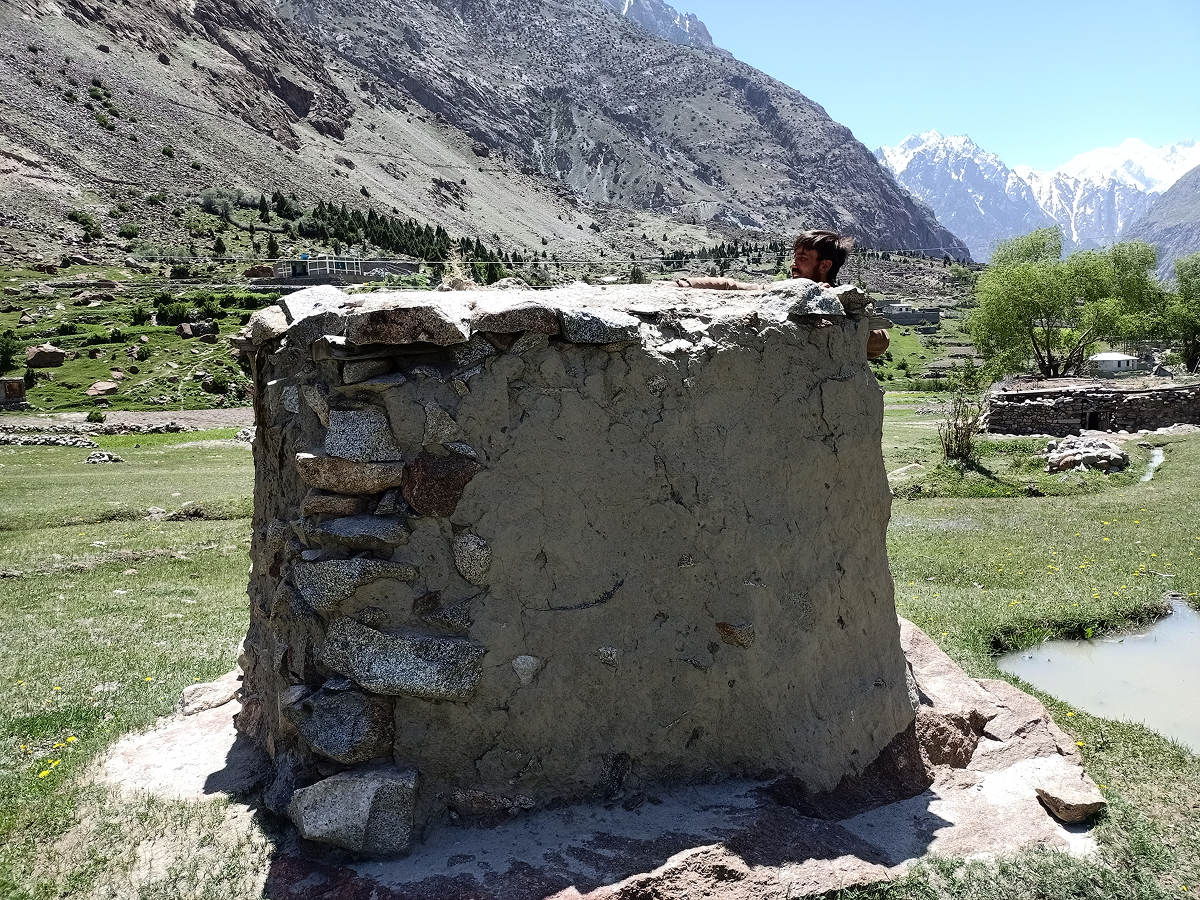

This essay examines the transformation of Ishkoman Valley from the proverbial ‘breadbasket’ of Gilgit-Baltistan into a landscape of paradoxes: terraces that once sustained food sovereignty now grow cash crops for distant markets, while communities that withstood centuries of mountain winters are dependent on wheat trucks snaking along the KKH from the plains of Punjab, Pakistan. The region now imports roughly 81 percent of its grain supply, or 150,000 metric tonnes, per annum (SJCPP 2022). For the financial year 2024–2025, the Federal Government of Pakistan has allocated 15.872 billion Pakistani rupees (PKR) for the government of Gilgit-Baltistan to procure 1.5 million metric tonnes of subsidized wheat for the region (GoGB 2025).
Gilgit-Baltistan, a “disputed territory,” is in a situation of permanent liminality (Tariq 2020) since it has been embroiled in the Kashmir issue with India since 1947. It remains devoid of political representation, in what some describe as a condition of “postcolonial colonialism” (Sökefeld 2005: 969). The 1970s were a watershed, when geopolitical events such as the Sino–Indian War (1962), the Indo–Pakistan War (1965) and East Pakistan’s secession (1971), and agitation by locals for democratic rights prompted Pakistan to consolidate control over Gilgit-Baltistan (Haines 2012).
A populist government in Pakistan abolished the Frontier Crimes Regulations[3], a feudal territorial structure of princely states, and restructured and expanded the state-subsidized food distribution system to the entire region between 1972 and 1974 (Dittrich 1995). According to Holden (2023), these subsidies were a strategic tool to integrate Gilgit-Baltistan into the Pakistani state and they hinged on a critical artery: the Karakoram Highway, completed in 1978 with Sino-Pakistani collaboration for strategic and territorial imperatives (Dinar 2023; Kreutzmann 2024: 212–33).
The KKH facilitated smooth access for Pakistani state institutions and international NGOs into Gilgit-Baltistan (Ali 2019), exposing it to global and transnational forces (Haines 2012). This intensification of communication and commercial exchange transformed livelihoods and regional agriculture. Juxtaposing the story of the KKH and the wheat subsidy regime demonstrates how infrastructure can simultaneously integrate and subordinate. It acts both as a lifeline and a leash.


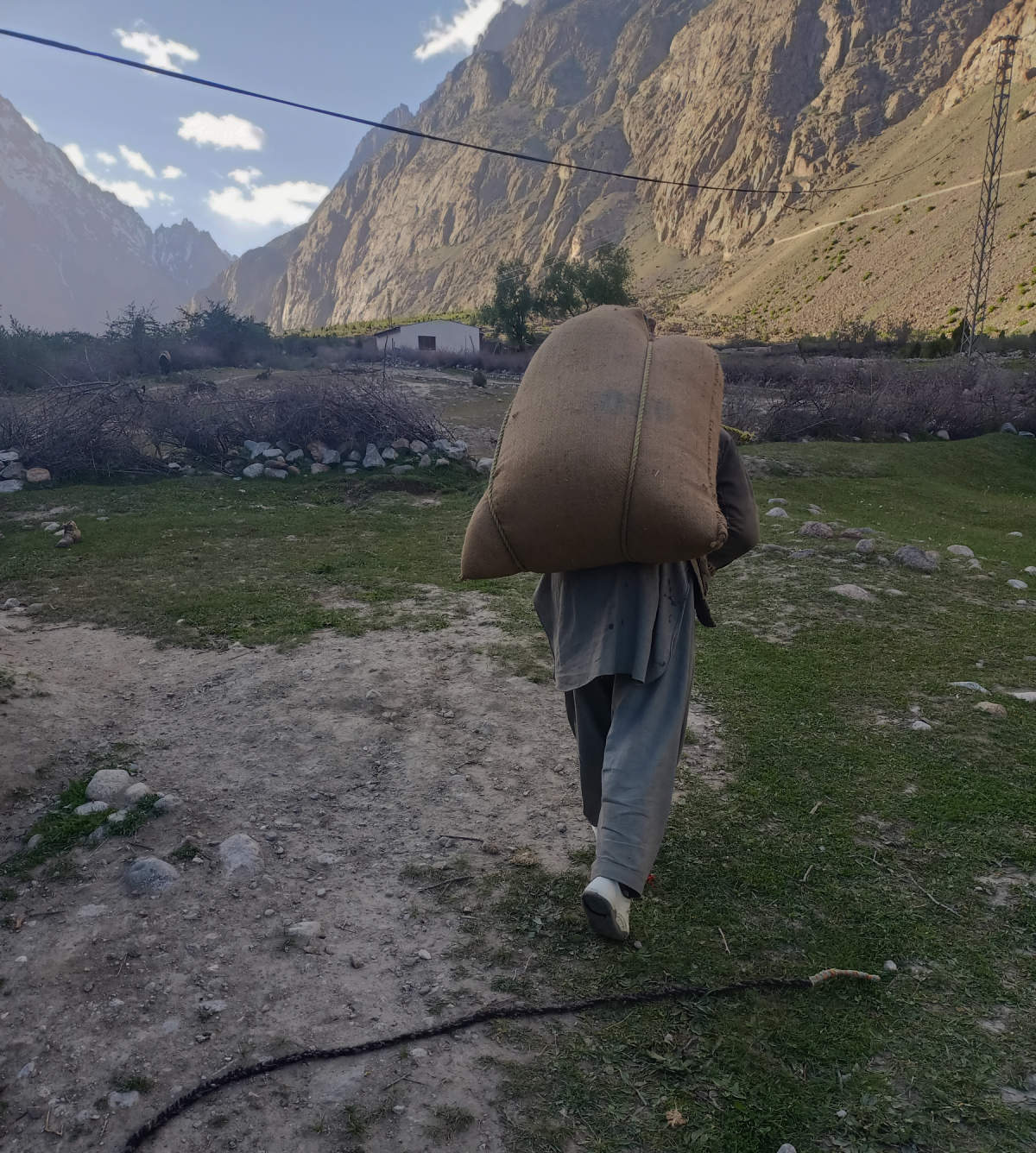
Traditional farming in Ishkoman is “mixed mountain agriculture” (Nüsser and Clemens 1996: 121), combining irrigated crop growing, livestock rearing and utilization of aylóq ( , ‘high summer pastures’). Before the arrival of the KKH, agriculture was small scale, subsistence based and ecologically attuned. Farmers maintained polycultures, diverse crop species, and fragmented yet productive landholdings (Staley 1969: 227; MacDonald 1998, 2010).
The opening of the KKH brought new actors, including state agencies and rural development schemes such as the Aga Khan Rural Support Programme and the Food and Agriculture Organization (Spies 2019). The highway acted as the essential infrastructure that made the wheat subsidy policy logistically possible and politically effective, thereby enabling the state to reshape the region’s agrarian economy. Subsidized wheat supplies, introduction of high-yield variety seeds, the promotion of horticulture and tuber crops (Abdullah 1972) were all part of development initiatives by the state.
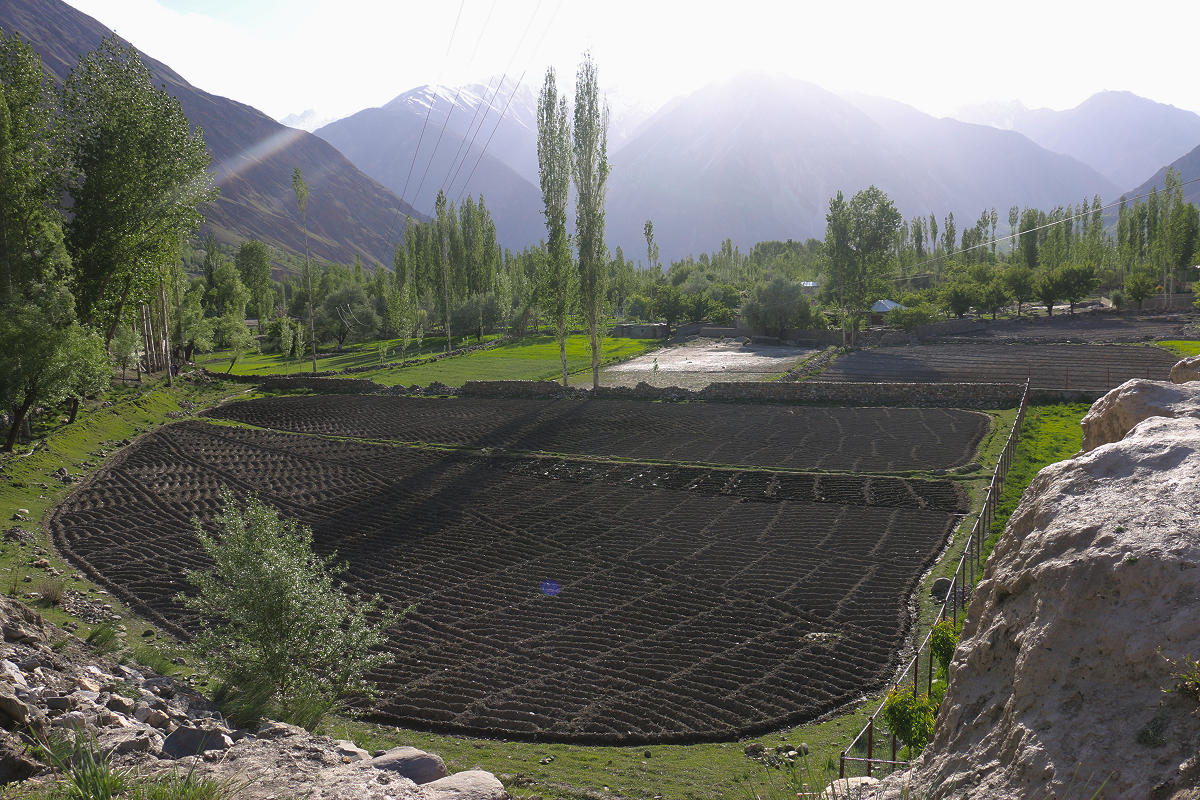

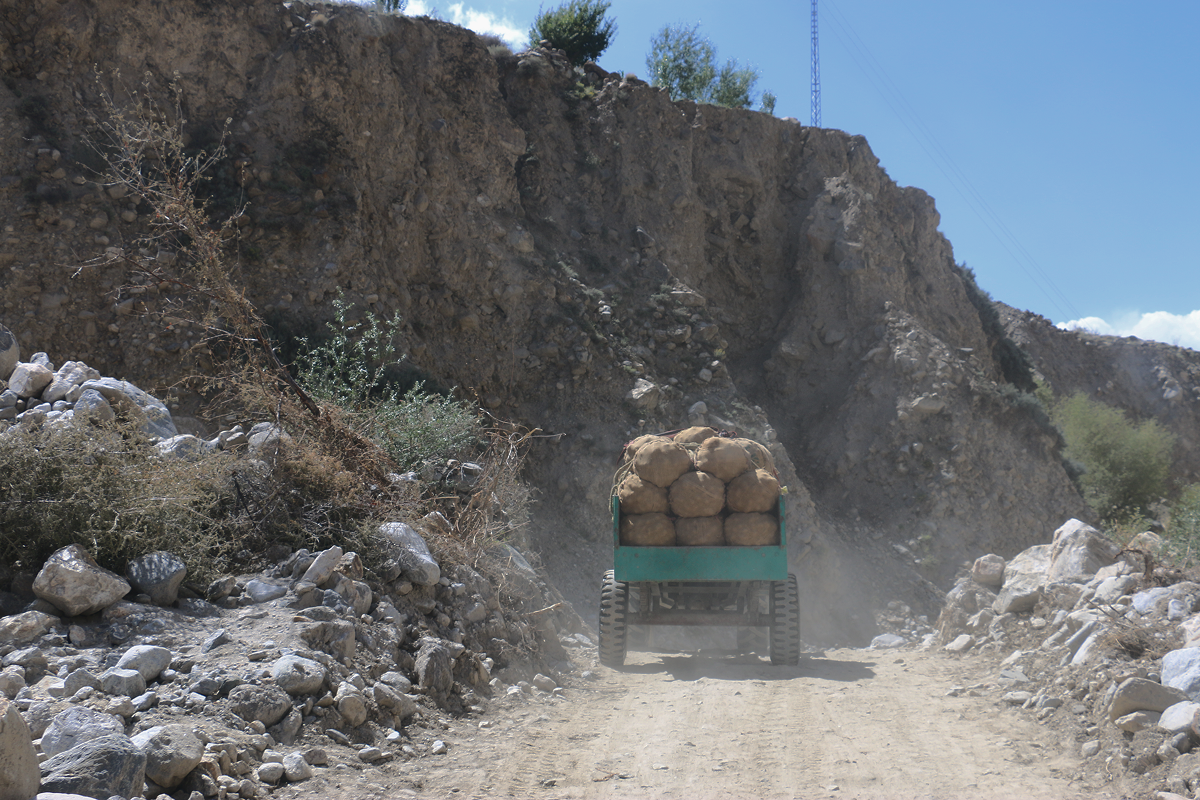
Historically, the area supplied wheat not only to neighboring regions such as the Pamirs (Whiteman 1985: 42) but also to military garrisons stationed there (Dittrich 1998). Today, however, it is classified as food-insecure (FAO 2019: 253), a stark reversal attributed to state policies that have prioritized commercial agriculture over subsistence farming. As early as 1972, the first government report on agricultural development in the region advocated subsidized staple foodstuffs brought from the plains of Punjab, thereby “freeing” mountain valleys to specialize in a range of cash crops such as potatoes and soft fruit (Abdullah 1972: 8–12). As one farmer in Chatorkhand Village, where I conducted my fieldwork in 2022, explained:
Subsidized wheat is really cheap. If we grow it on our own farms, it is costly, as we have to bear much more expense. The question is why we should grow it, when we can buy so cheaply from the state.
This disincentive of cheap wheat, coupled with the aggressive state promotion of cash crops, led to a dramatic decline in cereal cultivation. The area under orchards and potato cultivation has been continuously expanding, while the area of Gilgit-Baltistan under cereal farming has been declining and accounts today for just 17 percent of cultivated land (personal communication, director at Agriculture Research Institute 2022). The recent provincial agricultural policy clearly stated:
The goal of the policy options is not necessarily to maximize growth of production in any particular subsector/commodity but to create the necessary and sufficient conditions for the agricultural sector/farmers to adjust to a more competitive environment and raise their standards of living (GoGB 2018: 3).
This shows that the aim of the policy has been the integration of the region into market-oriented agriculture. Cheap subsidized wheat has played an instrumental role in this transition, instead of the needs of the local population.

Similarly, the aylóq – summer pastures traditionally used for barley farming – are now completely abandoned due to labour shortages and the convenience of subsidized wheat, further reducing local food production. The region has been rendered highly dependent on cheap, imported wheat, while its fertile land grows cash crops for faraway markets.[4] This shift has not only eroded the longstanding food sovereignty and agroecological knowledge but has also created a long-term dependency and undermined political sovereignty.
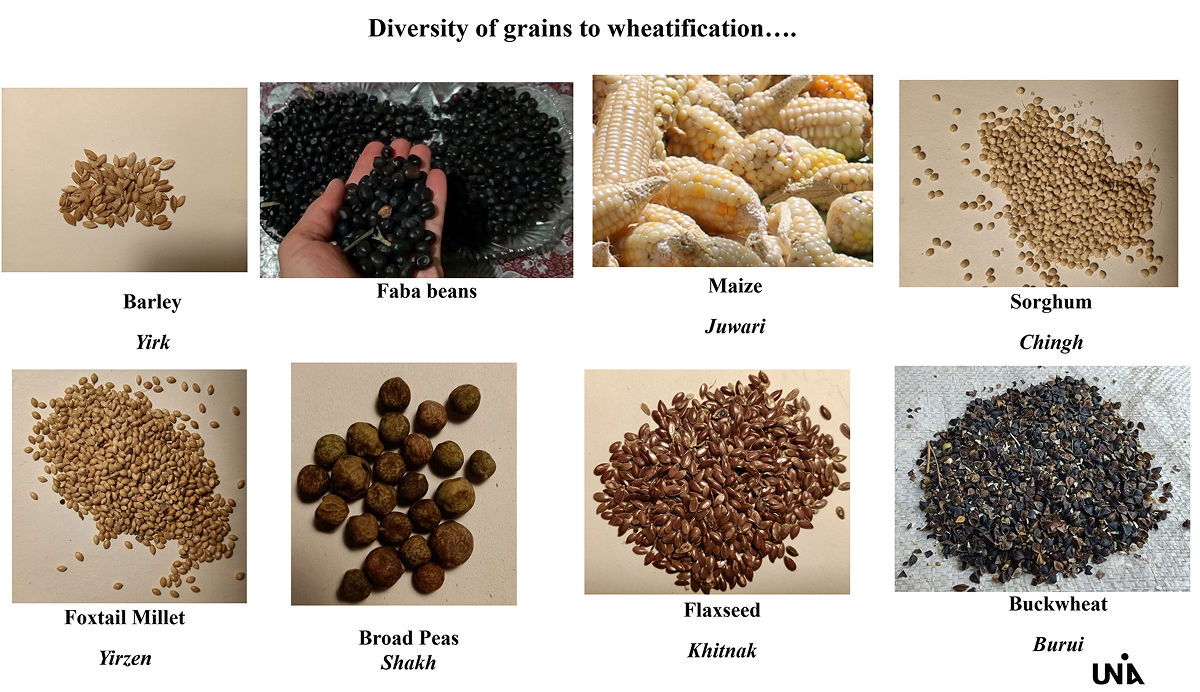
The loss here extends beyond empty granaries; it is just as much a loss of biological and cultural diversity. Historically, farmers cultivated eight or nine distinct grains, including local varieties of wheat such as Ladakhi, Bachgallian, Safaidak and Jaldak, as well as barley, buckwheat, fava beans, foxtail millet, maize, wild peas, lathyrus and sorghum. However, since the 1990s the shift towards cash crops – particularly potatoes and later to cherry orchards – along with the influx of subsidized wheat has disrupted traditional farming systems and reduced agro-biodiversity. As one farmer from Immit noted:
The change in agriculture here is that, firstly, wheat is accessible under subsidy, it is cheap... a 100kg sack costs… 2,000 PKR. However, because the subsidy is available, people don’t pay much attention to the cost or to farming itself. They have become tayarakhour [ – a local term referring to someone who consumes everything readymade and has nothing to do with production]. People just pay and take their sack of wheat home and use it.
The introduction of subsidized wheat has led to a ‘wheatification’ of the local diet, making it the dominant crop consumed as a cereal. This erosion of crop diversity mirrors a deeper epistemic rift (Schneider and McMichael 2010: 467–77): whenever elderly farmers shared the names of different cereals and varieties of wheat, it always left young people shocked as they were completely unaware of them – revealing a loss of local knowledge, history and methods of production.
Daulat Bibi’s empty ghuv stands as stark evidence: the KKH, a symbol of connection, became the instrument through which a unique local world was dismantled and made dependent, proving that infrastructure never just brings about positive outcomes. It has radically reshaped the Ishkoman Valley’s agrarian economy, food systems and dietary practices, with far-reaching social and political consequences. Before subsidies, the region cultivated a range of nutrient-rich grains which have now nearly vanished from both fields and diets. The loss of these indigenous crops extends beyond the local, reflecting a global pattern with serious implications for climate change resilience, regional food security, and the genetic diversity that underpins disease resistance (Mattioni et al 2023).
Daulat Bibi’s day now revolves around a different calendar: the arrival of government wheat in the depot, anxiety over quota changes, fear of the next price hike. The silent and empty ghuv is a museum to a past of self-reliance, while the sound of Shaukat’s tractor prepping for another potato harvest – a harvest that will travel along the same road that brings the wheat – is the sound of the present, a present of dependency.
Abdullah, Muhammad. 1972. Report on Prospects of Agricultural Development in Northern Areas (Gilgit and Baltistan). Islamabad: Pakistan Agricultural Research Council.
Ali, Nosheen. 2019. Delusional States: Feeling Rule and Development in Pakistan’s Northern Frontier. Cambridge: Cambridge University Press.
Dinar, Humera. 2023. “Women, Roads, and Development: Infrastructures of State-Making in Gilgit-Baltistan.” In The Palgrave Handbook of New Directions in Kashmir Studies, edited by Haley Duschinski, Mona Bhan and Cabeiri deBergh Robinson, 427–39. Cham: Springer International Publishing.
Dittrich, Christoph. 1998. “High-Mountain Food Systems in Transition: Food Security, Social Vulnerability and Development in Northern Pakistan.” In Transformation of Social and Economic Relationships in Northern Pakistan, edited by Irmtraud Stellrecht and Hans-Georg Bohle, 231–54. Köln: Köppe.
Dittrich, Christoph. 1995. “Ernährungssicherung und Entwicklung in Nordpakistan: Nahrungskrisen und Verwundbarkeit im peripheren Hochgebirgsraum.” Saarbrücken: Verlag für Entwicklungspolitik.
FAO, Food and Agriculture Organisation of the United Nations. 2019. Mountain Agriculture: Opportunities for Harnessing Zero Hunger in Asia. Bangkok: FAO. https://doi.org/10.4060/ca5561en
GoGB, Government of Gilgit-Baltistan. 2025. Wheat Subsidy to Gilgit-Baltistan. Unpublished Brief. Islamabad: Gilgit-Baltistan Council Secretariat.
GoGB, Government of Gilgit-Baltistan. 2018. Provincial Agriculture Sector Policy Gilgit-Baltistan. Gilgit-Baltistan, Gilgit: Department of Agriculture, Livestock and Fisheries.
Haines, Chad. 2012. Nation, Territory and Globalization in Pakistan: Traversing the Margins. New York: Routledge.
Holden, Livia. 2023. “People’s Struggle for Participatory Governance in Gilgit-Baltistan.” In The Palgrave Handbook of New Directions in Kashmir Studies, edited by Haley Duschinski, Mona Bhan and Cabeiri deBergh Robinson, 109–24. Cham: Springer International Publishing.
Kreutzmann, Hermann. 2024. Pamirian Crossroads and Beyond: Human Geography and Geopolitics. Leiden: Brill.
MacDonald, Kenneth Iain. 2010. “Landscapes of Diversity: Development and Vulnerability to Food Insecurity in Subsistence Agroecosystems of Northern Pakistan.” In Hunger Pains: Pakistan’s Food Insecurity, edited by Michael Kugelman and Robert M. Hathaway, 135–59. Washington, DC: Woodrow Wilson International Center for Scholars.
MacDonald, Kenneth Iain. 1998. “Rationality, Representation, and the Risk Mediating Characteristics of a Karakoram Mountain Farming System.” Human Ecology 26 (2): 287–321.
Mattioni, Bruna, Melanie Kessler-Mathieu, Donghai Wang, and Michael Tilley. 2023. “Ancient Grains: A Key Solution to Address Climate Change and Food Security.” In Sustainable Agricultural Practices and Product Design, edited by Amie Norton, Deanna Scheff and Leanne M. Gilbertson, 51–75. Washington, DC: American Chemical Society.
Nüsser, Marcus and Jürgen Clemens. 1996. “Impacts on mixed mountain agriculture in the Rupal Valley, Nanga Parbat, Northern Pakistan.” Mountain Research and Development 16 (2): 117–33.
Schneider, Mindi and Philip McMichael. 2010. “Deepening, and repairing, the metabolic rift.” The Journal of Peasant Studies 37 (3): 461–84.
SJCPP, Soni Jawari Centre for Public Policy, Government of Gilgit-Baltistan. 2022. A socio-economic profile of Gilgit-Baltistan: Baseline for green growth and inclusive development. Gilgit.
Sökefeld, Martin. 2005. “From Colonialism to Postcolonial Colonialism: Changing Modes of Domination in the Northern Areas of Pakistan.” The Journal of Asian studies 64 (4): 939–73.
Spies, Michael. 2019. Northern Pakistan: High Mountain Farming and Changing Socionatures. Lahore, Pakistan: Vanguard Books.
Staley, John. 1969. “Economy and Society in the High Mountains of Northern Pakistan.” Modern Asian Studies 3 (3): 225–43.
Tariq, Hamna. 2020. “The Permanent Liminality of Pakistan’s Northern Areas: The Case of Gilgit Baltistan.” Senior Thesis. Hartford, Connecticut: Trinity College.
Whiteman, P.T.S. 1985. “Mountain Oases: A Technical Report of Agricultural Studies (1982–1984) in Gilgit District, Northern Areas, Pakistan.” Gilgit: Department of Agriculture and FAO/UNDP Integrated Rural Development Project (Pak 80/009).
Students will be able to define ‘epistemic rift’ in the context of food systems, collect qualitative data through interviews, and critically evaluate modern food trends against historical local knowledge.
Students conduct a recorded interview with an elderly family member or community farmer about dietary changes over their lifetime.
Students write a two-page report analysing their findings:
Class discussion: ‘The Superfood Solution? ’ Given the loss of local food diversity and knowledge you have documented, is the trend of buying globally sourced ‘superfoods’ a solution to our nutritional problems, or does it worsen the epistemic rift?